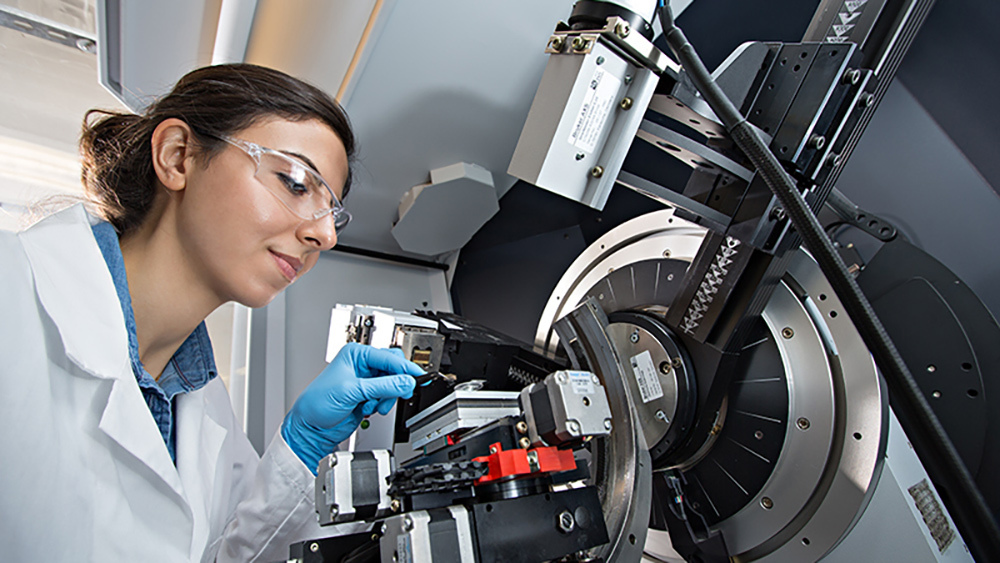
A new method to grow single crystals and simultaneously control their growth orientation without melt processing has been discovered by Texas A&M University materials science and engineering doctoral graduate Dr. Hande Ozcan and Dr. Ibrahim Karaman, department head and Chevron Professor.
The discovery of this new crystal growth and orientation control method in solid-state was recently published in the journal Acta Materialia. The research paper focuses on growing large single crystals and their ability to change their crystallographic orientation. Crystallographic orientation describes the alignment of the crystals within a bulk specimen.
“We have been working on single crystals over the last three decades, but growing the crystals with melt processing and controlling their orientations has been quite challenging,” Karaman said. “The method Hande discovered now saves us a lot of time and provides more flexibility. There is more to explore; that’s what makes us excited about this new method.”
According to the research paper, controlling the size, shape and crystallographic orientation of single crystals is vital to exploit the desired properties. Ozcan said this method is important for applications that require materials with anisotropic properties.
"This mechanism allows these materials to change their orientation in solid-state without cumbersome and costly melt processing techniques. This is important because these materials exhibit different properties when they have different crystallographic directions,” Ozcan said.
For the first time, Ozcan has seen crystallographic orientations can be changed at this large scale.
“This could fundamentally change how we look at single crystals and manipulate materials properties, because with solid-state methods, we can not only grow large single crystals very easily, but at the same time, we can now play with their crystallographic orientation,” Ozcan said.
Single crystals are essential to microelectronics, optical crystals, magnetic devices, solar cells, piezoelectric components and multifunctional alloys. One specific use case example for these materials is multifunctional shape memory alloys. These materials can change their shape and recover upon applying heat or stress.
"For example, you can deform the material when you apply a load, but when you release it, it returns to its original shape,” Ozcan said.
These properties strongly depend on the orientation of the single crystal; some orientations exhibit this recovery in a perfect fashion, and some do not. Thus, the orientation control is critical in obtaining superior functional properties.
Another advantage to this technique, according to the research paper, is that it does not require complex and expensive equipment.
Traditionally, melt-growth techniques, called the Bridgman and Czochralski processes, are used to obtain large crystals with a preferred orientation. However, controlling the crystal orientation is still challenging.
These methods rely on the availability of proper seed crystals, precise nucleation and thermal profile control during processing.
Because of this complexity, these methods are very expensive. The new method is called the solid-state crystal growth (SSCG) technique, a method where large bulk crystals with different crystallographic orientations could be made with simple heat treatments.
In this process, the crystals produced are more versatile and can achieve better chemical homogeneity than in the traditionally used melt-growth techniques.
The research team at Texas A&M demonstrated the SSCG method in two alloy systems, FeMnAlNi and CuMnAl, and achieved repeated, massive orientation changes in the solid state.
These findings offer a new strategy for manipulating the orientation of large single crystals on demand to take advantage of their superior and highly anisotropic properties, according to the research paper.
"This process works with materials that have semicoherent precipitates and that have two-phase regions in their phase diagram," Ozcan said. "When you cycle the material from high to low temperatures in a two-phase region multiple times, precipitates nucleate and dissolve and leave subgrain boundaries behind. Then the grains start to grow, decreasing the excess subgrain boundary energy. These grains continue to grow and merge, and finally, you can get a single crystal.”
When you continue to cycle the material after it becomes a single crystal, there are no other ways to reduce the excess energy in the system, and it activates a mechanism that changes its crystallographic orientation.
"We actually discovered this technique while we were working on something else. We were not specifically targeting to change the crystallographic orientation," Ozcan said. "We were just working on growing large single crystals."
During that process, Ozcan and the team found that in just a few cycles, the alloys would turn into single crystals, and with additional cycles, she realized that the orientation of the single crystals started to change completely.
"I showed the results to Dr. Karaman, and I was so excited," she said. "After that, we started understanding what was going on and why the crystal orientation was changing; we tried different methods and processing schedules in order to manipulate this change.
This discovery will open up extensive research areas, she said. This is just the beginning of this exciting new path of finding new materials.